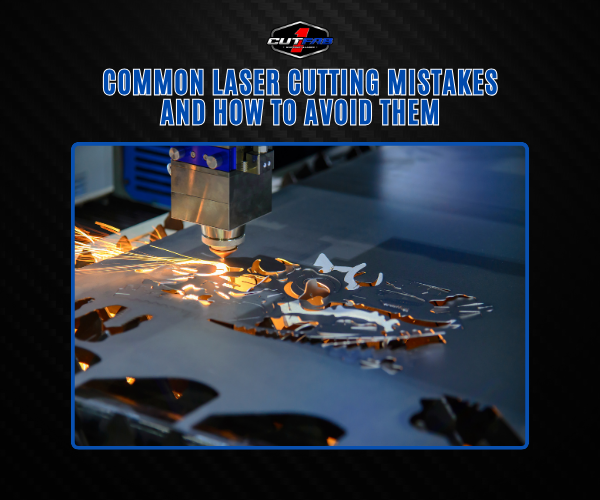
Common Laser Cutting Mistakes and How to Avoid Them!
Laser cutting is one of the most precise and efficient manufacturing processes available today—but even the smallest errors can lead to costly setbacks. Whether you're a seasoned professional or just starting out, understanding common laser cutting mistakes is critical to improving results and reducing waste. From incorrect settings to material mishandling, these missteps can sabotage your workflow. In this blog, we’ll explore the most frequent issues faced during laser cutting and, more importantly, how to avoid them. Ready to take your laser cutting game to the next level? Let’s dive in.
Top Mistakes – Improper Setup & Wrong Materials
When it comes to laser cutting mistakes, two of the most common (and costly) are improper machine setup and using the wrong materials. These errors might seem minor, but they can lead to inconsistent cuts, damaged equipment, and wasted resources.
Improper Setup
Incorrect laser settings—like power, speed, and frequency—can ruin a project before it even starts. For example, too much power can burn through thin materials, while too little may not cut at all. Calibration is another overlooked step; a misaligned laser head throws off accuracy and increases rework time. Always double-check your setup before hitting "Start."
Wrong Materials
Not all materials are laser-friendly. Using plastics like PVC can release toxic fumes, and reflective metals can damage the laser itself. Stick to certified laser-compatible materials, and always review the manufacturer’s recommendations.
Avoiding these fundamental mistakes can dramatically improve your output and extend the life of your machine.
Prevention Tips – Focus, Air Assist & Maintenance
Avoiding laser cutting mistakes isn't just about knowing what goes wrong—it's about building a process that prevents those mistakes from happening in the first place. Three of the most important (yet often neglected) elements are proper focus, effective air assist, and regular maintenance.
Dial in the Focus
A perfectly focused laser ensures clean, precise cuts. If the laser is even slightly out of focus, edges become rough and incomplete. Most machines come with focus tools—use them every time. It’s a simple habit that can save hours of rework.
Use Air Assist
Air assist helps clear debris, cool the cutting area, and reduce the risk of flare-ups. Without it, materials char or catch fire, and your cuts suffer. Make sure your air pump is functioning properly and filters are clean.
Routine Maintenance
Dirty mirrors, lenses, or a clogged exhaust system will degrade performance. Set a regular maintenance schedule to clean optics, check alignment, and inspect components.
Consistency here is key—these simple habits can eliminate 80% of common laser cutting mistakes.
Design File Issues
One of the most overlooked laser cutting mistakes stems from the very beginning of the process: your design file. You can have the most powerful laser cutter in the world, but if your file isn't prepared correctly, the final product will suffer—guaranteed.
-
File Format Confusion
Always check your machine’s requirements for file format compatibility. Many users mistakenly upload raster images (.jpg, .png), thinking they’re ready to go. In reality, laser cutters require vector files—typically .AI, .SVG, .DXF, or .EPS—for precision cuts. Raster files are better suited for engraving, not cutting.
-
Incorrect Line Settings
Another common issue? Line thickness. Laser cutters often require hairline strokes (0.001 inch or less) to interpret a line as a “cut.” Anything thicker can be read as an engraving. Overlooking this can result in your design being etched instead of cut—wasting time and material.
-
Overlapping or Duplicate Paths
Duplicate lines or overlapping paths can lead to multiple passes of the laser on the same spot. This not only slows down production but can cause burns, warping, or even fire hazards. Before exporting your file, zoom in and inspect all paths to ensure they're clean and singular.
-
Missing or Unjoined Nodes
If your vector paths aren’t properly joined, you may end up with incomplete cuts or dropped pieces. Always run a path validation before sending your file to the machine.
Fixing these design file issues upfront can prevent costly errors later and ensure smoother, more efficient production.
Working with Professionals
If you're serious about avoiding laser cutting mistakes, sometimes the smartest move is to bring in the pros. Whether you're handling a high-volume production job or working with expensive materials, collaborating with experienced professionals can save you time, money, and a lot of frustration.
- Why It Matters
Professionals bring years of experience, technical know-how, and access to industrial-grade equipment. They’ve seen the most common errors—wrong settings, poor focus, incompatible designs—and know exactly how to prevent them. They also understand how different materials react to heat, ensuring clean, consistent results every time.
- Getting It Right the First Time
A seasoned technician will spot design file issues before a single cut is made. They'll adjust laser parameters for optimal precision, recommend better materials if needed, and follow strict maintenance routines that hobbyists often skip. That level of attention minimizes risk.
- Peace of Mind
When deadlines are tight and quality matters, working with professionals isn’t just convenient—it’s strategic.
Conclusion
Avoiding laser cutting mistakes isn’t about perfection—it’s about preparation. From properly setting up your machine to choosing the right materials and cleaning up your design files, small steps make a big impact. Whether you’re a DIY enthusiast or managing production for a business, understanding these common errors and how to prevent them will save you time, reduce waste, and improve overall results.
And remember—if things get complex, don’t hesitate to work with professionals. Their insight can elevate your project and help you avoid costly setbacks. Now that you know what to watch out for, it’s time to laser smarter, not harder.
